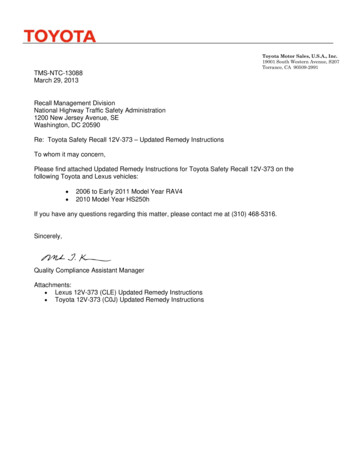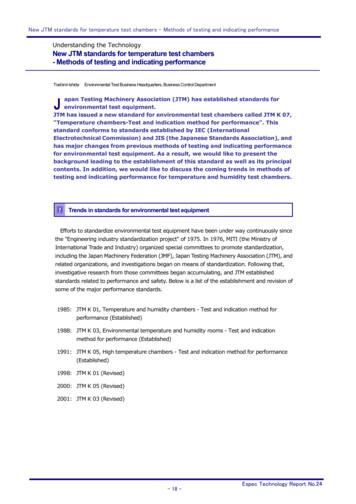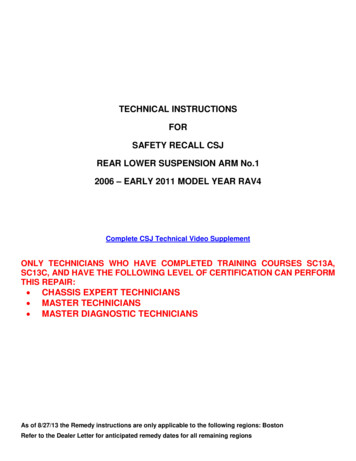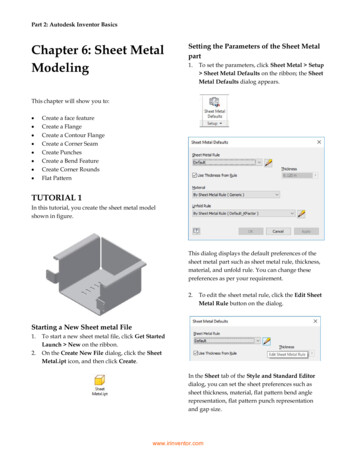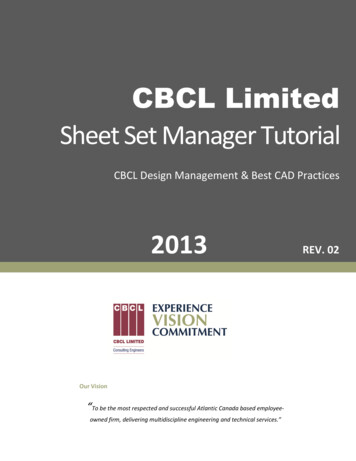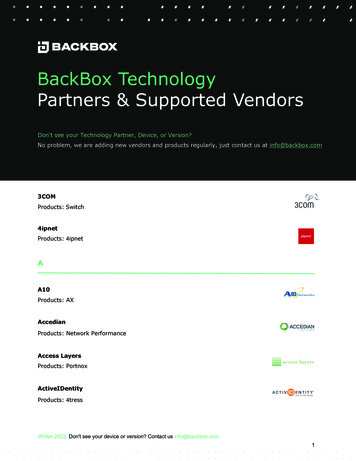
Transcription
Issue Date 18-Feb-2014Revision Date: 28-Feb-2022SAFETY DATA SHEETVersion 51. IDENTIFICATIONGHS Product IdentifierProduct NameOther Means of IdentificationSDS #Chemical FormulaOther InformationEase On Water Dispersible Pipe Joint Lubricant11-4 or 11-4R1Recommended Use of the Chemical and Restrictions on UseRecommended UseLubricantDetails of the Supplier of the Safety Data SheetSupplier AddressJTM Products, Inc.31025 Carter StreetSolon, OH 44139Tel. 440-287-2302800-229-6744Fax. 440-287-3095Emergency Telephone NumberEmergency TelephoneChemtel 1-800-255-39242. HAZARDS IDENTIFICATIONClassificationThis chemical is considered hazardous according to the OSHA Hazard Communication Standard 2012 (29 CFR1910.1200)GHS classificationHazard categories:Skin Irritant 3Eye irritation: Eye Irritant 2BLabel elementsSignal word:WarningPage 1 / 8
Ease On Water Dispersible Pipe Joint LubricantRevision Date: 28-Feb-2022Hazard statementsH316 Causes mild skin irritation.H320 Causes eye irritation.Precautionary statementsP264P332 P313P305 P351 P338P337 P313Wash skin thoroughly after handling.If skin irritation occurs: Get medical advice/attention.IF IN EYES: Rinse cautiously with water for several minutes. Remove contact lenses,if present and easy to do. Continue rinsing.If eye irritation persists: Get medical advice/attention.3. COMPOSITION/INFORMATION ON INGREDIENTSComponentsCAS No.7732-18-568606-06-4EINECS271-723-9Chemical NameWaterMixed sodium and potassium salts of tall oil (soap)Quantity20-40%13-25%Ingredients not listed on this safety data sheet are considered to be non-hazardous according to OSHA 1910.1200 or are notpresent above their cutoff levels. Where a range is displayed, the exact percentage of composition has been withheld as a tradesecret.4. FIRST AID MEASURESFirst Aid MeasuresInhalationEye contactIngestionSkin ContactMove to fresh air. If symptoms persist, call a physicianRinse thoroughly with plenty of water for at least 15 minutes, lifting lower and upper eyelids.If symptoms persist, call a physician.Do NOT induce vomiting. Drink plenty of water. Rinse mouth. Never give anything by mouthto an unconscious person. Call a physician or poison control center immediatelyWash off immediately with soap and water. If skin irritation persists, call a physician.Most Important Symptoms and Effects, Both Acute and DelayedSymptomsDirect contact with eyes may cause temporary irritation. Prolonged or repeated skin contact may cause irritation.Page 2 / 8
Ease On Water Dispersible Pipe Joint LubricantRevision Date: 28-Feb-2022Indication of any Immediate Medical Attention and Special Treatment NeededNote to PhysiciansTreat symptomatically.5. FIRE-FIGHTING MEASURESSuitable Extinguishing MediaWater. Water spray (fog). Alcohol resistant foam. Carbon dioxide (CO2). Dry chemical.Unsuitable Extinguishing MediaCAUTION: Use of water spray when fighting fire may be inefficient.Specific Hazards Arising from the ChemicalNo information available.Hazardous Combustion ProductsSensitivity to Mechanical Impact NoneSensitivity to Static DischargeNoneProtective Equipment and Precautions for FirefightersAs in any fire, wear self-contained breathing apparatus pressure-demand, MSHA/NIOSH (approved or equivalent) andfull protective gear. Prevent runoff from fire control or dilution from entering streams, sewers, or drinking watersupply.6. ACCIDENTAL RELEASE MEASURESPersonal Precautions, Protective Equipment and Emergency ProceduresPersonal PrecautionsEnvironmental PrecautionsAvoid contact with the skin and the eyes. Evacuate personnel to safe areas. Usepersonal protective equipment. Keep people away from and upwind of spill/leak.Prevent further leakage or spillage if safe to do so. Prevent product from enteringdrains. Do not flush into surface water or sanitary sewer system. Prevent entry intowaterways, sewers, basements or confined areas. See Section 12 for additionalEcological informationMethods and Material for Containment and Cleaning UpMethods for ContainmentMethods for Cleaning UpDike to collect large liquid spills. Prevent leakage or spillage if safe to do so.Dam up. Soak up with inert absorbent material Place the bulk of any spilled materialinto properly labeled containers. Rinse any remaining material to sewage treatmentfacility. Clean up in accordance with all applicable regulations.7. HANDLING AND STORAGEPrecautions for Safe HandlingHandlingWear personal protective equipment. Avoid contact with skin, eyes and clothing. Do not breathevapors or spray mist. Ensure adequate ventilation. Use only in area provided with appropriateexhaust ventilation. Do not eat, drink or smoke when using this product. Wash thoroughly afterhandling. Do not take internally.Page 3 / 8
Revision Date: 28-Feb-2022Ease On Water Dispersible Pipe Joint LubricantConditions for Safe Storage, Including any IncompatibilitiesStorageKeep containers tightly closed in a dry, cool and well-ventilated place. Keep in properly labeledcontainers. Keep out of the reach of children.Incompatible Materials Strong oxidizing agents. Strong bases8. EXPOSURE CONTROLS/PERSONAL PROTECTIONControl ParametersAppropriate Engineering ControlsEngineering ControlsEyewash stationsShowersVentilation systems.Individual Protection Measures, such as Personal Protective EquipmentEye/Face ProtectionSkin and Body ProtectionWear approved safety goggles.Lightweight protective clothing. Chemical resistant gloves, if needed, to avoidprolonged or repeated skin contact.Respiratory ProtectionNo special protective equipment required. If respirators are used, OSHA requires awritten respiratory program that includes at least: medical certification training, fittesting, periodic environmental monitoring, maintenance, inspection, cleaning, andconvenient, sanitary storage areas.General Hygiene ConsiderationsAlways observe good personal hygiene measures, such as washing after handling thematerial and before eating, drinking, and/or smoking. Do not eat, drink or smokewhen using this product. Regular cleaning of equipment, work area and clothing isrecommended.Control ParametersN.A.9. PHYSICAL AND CHEMICAL PROPERTIESInformation on Basic Physical and Chemical PropertiesPastePhysical StateOff-White PasteOdorAppearanceColorOff-whiteOdor thresholdPropertypHMelting point/freezing pointBoiling point/boiling rangeFlash pointEvaporation rateFlammability (solid, gas)Values 9 0 C/ 32 F 104 C/ 220 F 104 C/ 220 FNot applicableNot determinedBlandNot determinedRemarks – Method5% solutionPage 4 / 8
Ease On Water Dispersible Pipe Joint LubricantFlammability Limits in AirUpper Flammability LimitsLower Flammability LimitsVapor PressureVapor DensitySpecific GravityWater SolubilitySolubility in other SolventsPartition CoefficientAutoignition TemperatureDecomposition TemperatureKinematic ViscosityDynamic ViscosityExplosive PropertiesOxidizing PropertiesRevision Date: 28-Feb-2022Not applicableNot applicableNot applicableNot applicable1.2Completely solubleNot determinedNot determinedNot determinedNot determinedNot determinedNot determinedNoneNoneOther InformationVOC Content (%) 5%10. STABILITY AND REACTIVITYReactivityNot reactive under normal conditionsChemical StabilityStable under recommended storage conditionsPossibility of Hazardous ReactionsNone under normal processingConditions to AvoidContact with incompatible materialIncompatible MaterialsStrong oxidizing agentsHazardous Decomposition ProductsCarbon oxides11. TOXICOLOGICAL INFORMATIONInformation on Likely Route of ExposureProduct InformationInhalationEye ContactSkin ContactIngestionSymptomsNot a likely route of exposureCauses eye irritationMay cause mild skin irritationDo not taste or swallowDirect contact with eyes may cause temporary irritation. Prolonged or repeatedcontact may dry skin and cause irritationPage 5 / 8
Ease On Water Dispersible Pipe Joint LubricantRevision Date: 28-Feb-2022Delayed and Immediate Effects as well as Chronic Effects from Short and Long-Term ExposureCarcinogenicityThis product does not contain any carcinogens or potential carcinogens as listed byOSHA, IARC or NTPNumerical Measures of Toxicity – ProductThe following values are calculated based on chapter 3.1 of the GHS document:LD50 Oral22665 mg/kg; Acute toxicity estimate mg/kg mg/L12. ECOLOGICAL INFORMATIONEcotoxicityThe environmental impact of this product has not been fully investigated.Persistence and DegradabilityNo information available.MobilityNot Determined.Other Adverse EffectsNot Determined.Waste Treatment MethodsDisposal of WastesContaminated Packaging13. DISPOSAL CONSIDERATIONSDisposal should be in accordance with applicable regional, national and local laws andregulations. Contact your supplier or a licensed contractor for detailedrecommendations.Do not re-use empty containers. Disposal should be in accordance with applicableregional, national and local laws and regulations.14. TRANSPORT INFORMATIONDOTIATAIMDGNot regulatedNot regulatedNot regulated15. REGULATORY INFORMATIONInternational InventoriesTSCAAll ingredients appear on inventoryDSL/NDSLAll components of this product are listed or are exemptEINECS/ELINCS - European Inventory of Existing Chemical Substances/European List of Notified Chemical Substances/ not available (N.A.)ENCS –Japan Existing and New Chemical Substances/not available (N.A.)IECSC –China Inventory of Existing Chemical Substances/not available (N.A.)KECL –Korean Existing and Evaluated Chemical Substances/not available (N.A.)PICCS –Philippines Inventory of Chemicals and Chemical Substances/not available (N.A.)Page 6 / 8
Revision Date: 28-Feb-2022Ease On Water Dispersible Pipe Joint LubricantLegend:TSCA - United States Toxic Substances Control Act Section 8(b) InventoryDSL/NDSL – Canadian Domestic Substances List/Non-Domestic Substances ListEINECS/ELINCS - European Inventory of Existing Chemical Substances/European List of Notified Chemical SubstancesENCS – Japan Existing and New Chemical SubstancesIECSC – China Inventory of Existing Chemical SubstancesKECL – Korean Existing and Evaluated Chemical SubstancesPICCS – Philippines Inventory of Chemicals and Chemical SubstancesUS Federal RegulationsSection 313 of Title III of the Superfund Amendments and Reauthorization Act of 1986 (SARA). This product does notcontain any chemicals which are subject to the reporting requirements of the Act and Title 40 of the Code of FederalRegulations, Part 372.SARA 311/312 Hazard CategoriesAcute Health HazardChronic Health HazardFire HazardSudden Release of Pressure HazardReactive HazardCWA (Clean Water Act)NoNoNoNoNoThis product contains the following substances which are regulated pollutants pursuant to the Clean Water Act (40 CFR122.21 and 40 CFR 122.42): None knownCERCLAThis material, as supplied, contains one or more substances regulated as a hazardous substance under theComprehensive Environmental Response Compensation and Liability Act (CERCLA) (40 CFR 302): None KnownU.S. State RegulationsCalifornia Proposition 65This product does not contain any Proposition 65 chemicals.U.S. State Right-to-Know Regulations: Not applicableU.S. EPA Label InformationEPA Pesticide Registration Number: Not Applicable16. OTHER INFORMATIONNFPAHMISIssuance DateRevision DateRevision NoteHealth Hazards1Health ical Hazards018-Feb-201428-Feb-2022Section 15: Removed Acute Health HazardSpecial HazardsNot determinedPersonal ProtectionNot determinedPage 7 / 8
Ease On Water Dispersible Pipe Joint LubricantRevision Date: 28-Feb-2022DisclaimerThe information provided in this Safety Data Sheet is correct to the best of our knowledge, information andbelief at the date of its publication. The information given is designed only as a guidance for safe handling, use,processing, storage, transportation, disposal and release and is not to be considered a warranty or qualityspecification. The information relates only to the specific material designated and may not be valid for suchmaterial used in combination with any other materials or in any process, unless specified in the text.End of Safety Data SheetPage 8 / 8
JTM Products, Inc. 31025 Carter Street . Solon, OH 44139 . Tel. 440-287-2302 . 800-229-6744. Fax. 440-287-3095 . Emergency Telephone Number Emergency Telephone Chemtel 1-800-255-3924 . Classification This chemical is considered hazardous according to the OSHA Hazard Communication Standard 2012 (29 CFR 1910.1200) GHS classification . Hazard .
